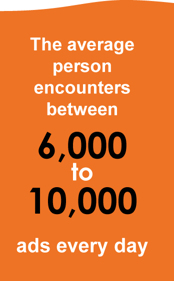Over reliance on data can destroy your ads
Ads are everywhere. On your social feed, in your favorite apps, the websites you frequent, along the street, all over your local stores. Although there are no official figures, in 2021, the average person encounters between 6,000 to 10,000 ads every day.
What’s that, you say? There’s no possible way you are exposed to that many ads. The truth is, your eyes may be lying to you.
Today we have an incredibly high visual attention load and, often, a meager attention span. Studies of visual perception demonstrate how surprisingly little people see when they’re not paying attention, a phenomenon known as “inattentional blindness.”
No relevance = bad ads
Why don’t we pay attention? Two reasons. The first is a concept called “Digital Sameness.” It refers to how in today’s world, everything digital—from web pages to mobile apps, even brand logos—tend to look the same, behave the same, and feature the same functionalities.The second reason is that many ads are simply “bad ads” that aren’t relevant, or worse, they are annoying. Annoying ads lead to people opting out of ads using online blockers, making it worse for all advertisers.
How did the marketing industry get here? A primary reason is an over reliance on data, audience segmentation, and tech capabilities to place the ads. Of course, data is essential. It just isn’t the be-all, end-all. If all we needed is data, then every campaign would work great. But they don’t. Studies show that, on average, media placement only accounts for about 30% of a brand’s campaign success.Worse, many advertisers spend a lot of time using data to find the right audiences only to deliver the same message to every person.
The power of good creative
Beyond data, how do we do better? We do better creative. After analyzing over 170,000 online creative executions, a recent study found that the quality of creative was 50% to 75% responsible for campaign success or failure. Forrester highlighted this issue some time ago in a paper titled “The Cost Of Losing Creativity” and called out that investing in creativity will help firms achieve higher returns over a six-year period.
Yes, the art of our business can improve your brand messaging. Key is to ensure relevancy and to use the medium effectively.
“There are four key components of digital campaigns, each carrying a different contribution to performance: data, audiences, creative/message, and the call to action. Data and audiences contribute about 30% of campaign performance, with the call to action another 10-20%. Based on thousands of tests, aligning advertising creative, message, and imagery drives up to 60% of performance. There more significant financial return by investing in relevant creative.”
-Mark Henneges, The Interactive Shop
What to Do About it:
The SellCheck POV
SellCheck takes a scientific approach to help brands optimize performance marketing creative to increase conversion by an average of 30%. SellCheck’s4Cs assesses key steps in the viewer’s cognitive progression --using behavioral science to help so-so ads become great.
Command Attention
![]() Whether your message is online or in-person, there are several effective ways to break through inattentional blindness and digital sameness. Studies have consistently shown that our eyes are drawn to what’s different so the brain can best evaluate and consider a course of action. The lesson is simple: stand out or risk being ignored.
Whether your message is online or in-person, there are several effective ways to break through inattentional blindness and digital sameness. Studies have consistently shown that our eyes are drawn to what’s different so the brain can best evaluate and consider a course of action. The lesson is simple: stand out or risk being ignored.
Connect with the End-User
![]() Let’s be honest. People are not standing around waiting for ads. If your message does not register as recognizable and relevant, it results in inattentional blindness. Don’t assume the shopper will instantly recognize the brand and category. Intelligent marketers leverage the key images and cues for the category and known brand equities. We are each more inclined to listen when we know who is speaking to us.
Let’s be honest. People are not standing around waiting for ads. If your message does not register as recognizable and relevant, it results in inattentional blindness. Don’t assume the shopper will instantly recognize the brand and category. Intelligent marketers leverage the key images and cues for the category and known brand equities. We are each more inclined to listen when we know who is speaking to us.
Convey Information
![]() Now’s not the time to be cute. Tell a straightforward story and emphasize your product or service benefits. Be single-minded in your approach to creativity rather than trying to include every message possible. Too often, we see cluttered ads that are difficult to understand upon deep study, let alone at a quick glance.
Now’s not the time to be cute. Tell a straightforward story and emphasize your product or service benefits. Be single-minded in your approach to creativity rather than trying to include every message possible. Too often, we see cluttered ads that are difficult to understand upon deep study, let alone at a quick glance.
Close the Sale
![]() The best marketers understand audience motivations and barriers and strive to eliminate any doubt about the purchase. Being clear on product claims and the reasons to believe will help Close the sale. Speaking of which, don’t be afraid to ask for the sale specifically.
The best marketers understand audience motivations and barriers and strive to eliminate any doubt about the purchase. Being clear on product claims and the reasons to believe will help Close the sale. Speaking of which, don’t be afraid to ask for the sale specifically.



